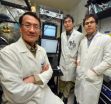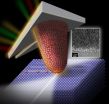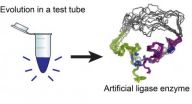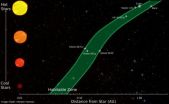(Press-News.org) BEND, Ore. – A new study by Oregon State University researchers finds that Head Start can make a positive impact in the lives of some of its highest risk children, both academically and behaviorally.
Published in the current issue of the Journal of Applied Developmental Psychology, the study sheds light on how Head Start has helped children living in non-parental care, or living with someone who is not a parent or step-parent by biology or adoption.
"These children tend to have unstable home lives, sometimes transitioning between different relatives, living with their grandma one month, and later with an aunt or other family member," said lead author Shannon Lipscomb, an assistant professor of human development and family sciences at OSU-Cascades.
"These are kids who face heightened risk factors even beyond those of other children living in poverty. They are more similar to what we find in kids in child welfare. They have a lot of challenges in their lives, and the stresses of that can cause behavioral and development issues."
The researchers obtained data from the Head Start Impact Study, a nationally representative sample of Head Start programs and families commissioned by the federal government. Head Start provides comprehensive early child development services to low-income children and their families. That original study, published in 2010, looked at the general population of children attending Head Start programs, but did not examine impacts for children living in non-parental care.
"Children in non-parental care showed more problems with academics, behavior, and a wide variety of risk factors at the beginning of the study," Lipscomb said. "In addition, Head Start is designed as a wrap-around program, which links child, teacher, and parent. So we wanted to know if this model even works for kids who don't have a traditional family, and may have different caregivers at any given time."
The researchers found that Head Start appears to be as beneficial for this group of children as it is for the general population of children living in poverty who attend the program. Analyzing the data on 253 children in non-parental care, they found the program had short-term positive impacts on school readiness, particularly in regards to early academic skills, positive teacher-child relationships, and a reduction in behavior problems.
"Our findings show Head Start is at least as effective for this very high risk group as prior studies have shown that it is for other children," Lipscomb said. "The impact we saw was modest, not huge, but statistically significant. We think the positive impact on child-teacher relationships is especially important."
Lipscomb said this was a new finding; prior analysis of Head Start's impacts on children who live with their parents haven't found this effect.
Lipscomb is an expert on early childhood development, with an emphasis on preschool and early child care experiences, and how those early social experiences help kids prepare for success in life. Her work focuses on children from at-risk backgrounds.
"Children in non-parental care tend to struggle with socio-emotional development, likely due to the risk factors they experience such as transitioning between homes, special needs, and behavioral problems," she said. "Perhaps as a result of Head Start's whole-child focus and standards for teacher qualifications, their teachers may be more effective than caregivers in other types of programs in establishing positive relationships with children who have high needs."
INFORMATION:
OSU doctoral students Megan Pratt and Sara Schmitt, as well as Katherine Pears and Hyoun Kim of the Oregon Social Learning Center, contributed to this study.
Academic gains, improved teacher relationships found among high risk kids in Head Start
2013-01-30
ELSE PRESS RELEASES FROM THIS DATE:
Snails signal a humid Mediterranean
2013-01-30
An international team of researchers has shown that old wives' tales that snails can tell us about the weather should not be dismissed too hastily.
While the story goes that if a snail climbs a plant or post, rain is coming, research led by the University of York goes one better: it shows snails can provide a wealth of information about the prevailing weather conditions thousands of years ago.
The researchers, including scientists from the Scottish Universities Environmental Research Centre (SUERC), analysed the chemistry of snail shells dating back 9,000 to 2,500 years ...
Scientists learn more about how inhibitory brain cells get excited
2013-01-30
AUGUSTA, Ga. – Scientists have found an early step in how the brain's inhibitory cells get excited.
A natural balance of excitement and inhibition keeps the brain from firing electrical impulses randomly and excessively, resulting in problems such as schizophrenia and seizures. However excitement is required to put on the brakes.
"When the inhibitory neuron is excited, its job is to suppress whatever activity it touches," said Dr. Lin Mei, Director of the Institute of Molecular Medicine and Genetics at the Medical College of Georgia at Georgia Regents University ...
A new genre of 'intelligent' micro- and nanomotors
2013-01-30
Enzymes, workhorse molecules of life that underpin almost every biological process, may have a new role as "intelligent" micro- and nanomotors with applications in medicine, engineering and other fields. That's the topic of a report in the Journal of the American Chemical Society, showing that single molecules of common enzymes can generate enough force to cause movement in specific directions.
Peter J. Butler, Ayusman Sen and colleagues point out that enzymes — proteins that jump-start chemical reactions — are the basis of natural biological motors essential to life. ...
Penn research shows mechanism behind wear at the atomic scale
2013-01-30
PHILADELPHIA — Wear is a fact of life. As surfaces rub against one another, they break down and lose their original shape. With less material to start with and functionality that often depends critically on shape and surface structure, wear affects nanoscale objects more strongly than it does their macroscale counterparts.
Worse, the mechanisms behind wear processes are better understood for things like car engines than nanotech devices. But now, researchers at the University of Pennsylvania's School of Engineering and Applied Science have experimentally demonstrated ...
Researchers improve medical units to reduce nursing fatigue, cut costs
2013-01-30
ITHACA, N.Y. – In hospitals, poor floor design, storage closet clutter and crowded corridors can contribute to nurse and medical staff fatigue. These distractions can hurt patient care quality and result in higher medical costs.
Now, a new Cornell University study offers a spatial solution.
Rana Zadeh, Cornell assistant professor of design and environmental analysis in the College of Human Ecology, analyzed the floor plans and work patterns within five medical-surgical units at U.S. hospitals and found numerous opportunities to boost nurses' efficiency through better ...
Conflicting cultural identities may foster political radicalism
2013-01-30
New research suggests that dual-identity immigrants — first-generation immigrants and their descendants who identify with both their cultural minority group and the society they now live in — may be more prone to political radicalism if they perceive their two cultural identities to be incompatible.
The new research is published in Psychological Science, a journal of the Association for Psychological Science.
Psychological scientist Bernd Simon from Kiel University in Germany and colleagues hypothesized that perceived incompatibility between the two cultural identities ...
Aging cells lose their grip on DNA rogues
2013-01-30
PROVIDENCE, R.I. [Brown University] — Even in our DNA there is no refuge from rogues that prey on the elderly. Parasitic strands of genetic material called transposable elements — transposons — lurk in our chromosomes, poised to wreak genomic havoc. Cells have evolved ways to defend themselves, but in a new study, Brown University researchers describe how cells lose this ability as they age, possibly resulting in a decline in their function and health.
Barbara McClintock, awarded the Nobel Prize in 1983, made the original discovery of transposons in maize. Since then ...
GEOLOGY starts 2013 with 25 new articles posted online ahead of print
2013-01-30
Boulder, Colo., USA - Geology content posted online 4 through 25 January 2013 cover topics from greenhouse gas emissions to video observations of erupting geysers in Russia and from the age of Earth to the age of Grand Canyon. Highlights and detailed information about each article are listed below.
1. Earth is mostly flat
2. Age maps of early Earth
3. Sagaing fault, Indo-Burmese wedge
4. Anthropogenic lead
5. The growth of a newly born submarine volcano
6. The Hemlo gold deposit, Ontario, Canada
7. Reptile and mammal fossils in the Karoo Basin, South Africa
8. ...
U. of Minn. researchers unveil first artificial enzyme created by evolution in a test tube
2013-01-30
There's a wobbly new biochemical structure in Burckhard Seelig's lab at the University of Minnesota that may resemble what enzymes looked like billions of years ago, when life on earth began to evolve – long before they became ingredients for new and improved products, from detergents to foods and fuels.
Seelig created the fledgling enzyme by using directed evolution in the laboratory. Working with colleague Gianluigi Veglia, graduate student Fa-An Chao, and other team members, he subsequently determined its structure, which made its debut December 9 as an advance online ...
Researchers develop model for identifying habitable zones around star
2013-01-30
UNIVERSITY PARK, Pa. -- Researchers searching the galaxy for planets that could pass the litmus test of sustaining water-based life must find whether those planets fall in a habitable zone, where they could be capable of having liquid water and sustaining life. New work, led by a team of Penn State researchers, will help scientists in that search.
Using the latest data, the Penn State Department of Geosciences team has developed an updated model for determining whether discovered planets fall within a habitable zone. The work builds on a prior model by James Kasting, ...






